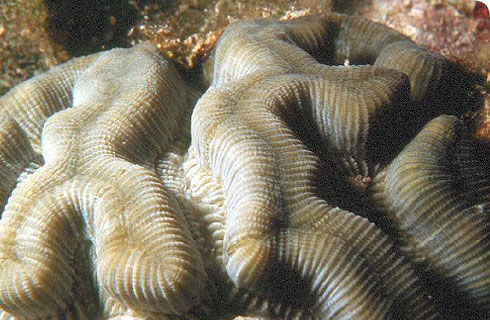Taxonomy
On the oral surface of the colony there is typically one continuous branching meandroid valley. This can be discontinuous if the corallum has been damaged during the life of the colony.
Septa are plate-shaped and not perforated, and characterised by two lobes - a small inner lobe and larger outer lobes.
Septal margins have small pointed teeth extending from upper and inner margins.
Lateral margins of septa have similar small pointed teeth arranged in parallel or slightly fanning rows oriented in the oral-aboral (up/down) direction, with each row on the lateral face corresponding with a tooth on the edge of the septum.
Septa might alternate in size - thicker and more protruding major septa alternate with thinner, less strongly ornamented, minor septa. In 5mm, there will be 6–7 major and 12–13 total septa.
The wall is septothecal and is formed from thickened adjacent septa that form a sheet.
The columella is continous and spongy, and is formed from twisted projections of the inner margins of septa.
The underside of colonies is typically covered by thick white coating called epitheca.
Evolution
The genus Manicina sp. includes over 10 species, but Manicina areolata is the only species that survives today.
The Miocene and Pliocene (24 million to 1.6 million years ago) were the heydey of Manicina when a range of species lived in shallow and deep-water habitats associated with small patch reefs in the Caribbean sea.
About 1 million years ago, approximately half the species of reef-corals living in the Caribbean became extinct, and Manicina was especially strongly hit.
Look-alikes
Meandrina braziliensis is a coral that looks superficially similar to Manicina areolata but differs by having much smoother skeletal elements and a plate-shaped columella.
These characters mean that it is a member of the family Meandrinidae.
During Miocene and Pliocene (24 million–1.6 million years ago), Meandrina braziliensis was more common than Manicina areolata on reef flats in the Caribbean region.
During the Early Pleistocene (about 1 million years ago) Meandrina braziliensis became extinct in the Caribbean but survives as a refugee in northeastern Brazil.
